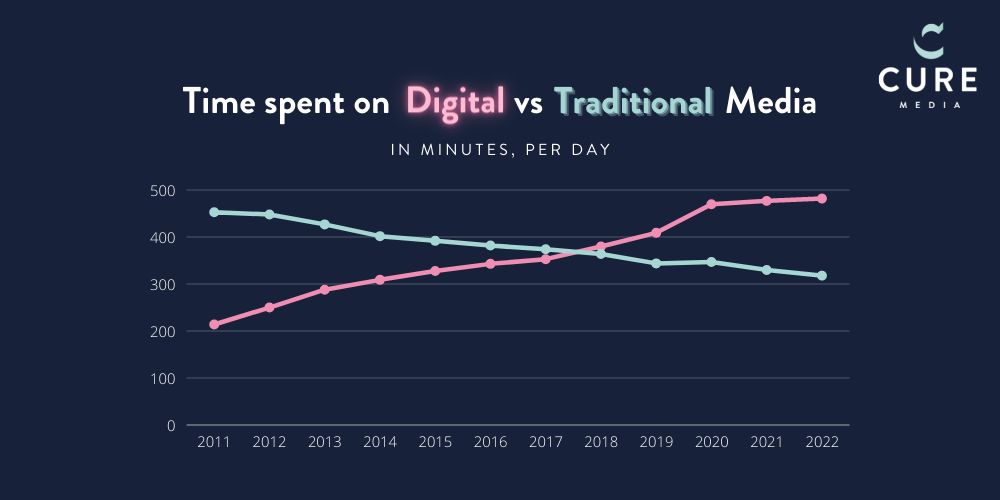“The only constant in life is change” says CEO and Co-Founder of Cure Media, Sam Foroozesh.
And as digital transformation continues to sweep the retail and marketing landscape, new players enter the market and new audiences dictate the rules of the game, this statement has never been more true.
We sat down with Sam to get more of his take on the three biggest change drivers business and marketing leaders need to be factoring into their strategy right now, as well as his advice on how to manage it.
1. Younger players enter the arena
So first things first, let’s get an overview of the consumer marketplace as it is right now…
We’re seeing a massive shift in the consumer scene right now. Millennials and Gen Z are no longer bit players. As they’ve aged up and – more importantly – into their purchasing power (even Gen Z are into their 20s now at the top end of their age bracket) they have begun to dictate what the businesses of tomorrow will look like.
But what if you’re not targeting younger consumers?
It’s important to remember that these two generations make up two-thirds of the global population. So that’s a huge and powerful portion of the consumer base to turn your back on. And that’s before you consider that even if you’re not your target customer right now, they almost certainly will be in 5 to 10 years. At what point are you planning on entering their consciousness? If you’re banking on opening the conversation only at the point that they become relevant to you then you might already be irrelevant to them.
2. Your channels should be changing
Younger consumers should definitely be on brands’ radars. What else do they need to bear in mind?
The digital shift. Now, digital transformation as a concept or even as a buzzword feels like it’s been around forever, so brands often make the mistake of assuming it’s done – digital transformation complete, time to move on.
But it’s not enough to have an online store anymore, or to tweet now and again. It’s scale that really matters at this juncture.
Shoppers today spend far more time on social media than they do watching TV or reading magazines like they would have done 20 or even 10 years ago. Yet many brands are still investing vast proportions of their budget into traditional advertising channels; they’re falling into the trap of familiarity. To really capitalise on the social media age, brands need to totally reconsider how they allocate their budget and resources and focus on growing their digital channels because that’s where their audience is.

3. Brand-generated content is no longer trusted
Traditional channels are out; digital is in. But is being present enough to keep brands top of mind?
Not at all. It’s not just where audiences are finding and consuming media that matters, it’s the kind of content brands are deploying. Consumers are absolutely overloaded with marketing messages nowadays and compounding this, they simply don’t trust brands. Traditional advertising has reached such a saturation level that consumers have become cynical.
So instead of looking to brands to hear where they should be spending their money as they know brands will be biased, they’re looking to impartial third parties and this generally means their peers or people they trust online.
With these three change drivers in mind, what can brands do to adapt and not just survive but thrive in this new playing field?
The important thing is to not stagnate. Don’t let fear of the unknown incapacitate you or drive you to sticking to what you know, because what you know isn’t going to work forever and may not even be working right now.
Evolution is essential in a market this competitive so start with your channels. Where you spend your budget, where you try to engage your audience – these decisions are the foundations of your marketing strategy and go a long way to determining its chances of success (or failure).
We know for a fact that social media is where not just younger consumers but most generations are now spending most of their time. In fact, even when they are watching TV, 88% of them are still using a second screen, browsing online or scrolling through their social feeds.
And even if you think your social strategy is on point, don’t rest on your laurels. In the digital age, things change fast. Just look at the insane adoption of the metaverse! Stay agile and keep looking for new ways to engage and entertain your audience.
And what about the content they’re deploying?
If channel choice is the ‘how’ in this triangle then your messaging is the ‘what’ and the ‘who’.
As we talked about earlier, one of the biggest challenges facing modern marketers is that audiences don’t trust them or their messages, and this is particularly relevant to younger consumers who have grown up in this hyper-saturated era of advertising.
If you want to engage this audience (and again, you should) then you’re going to have to dig deeper. Distribute content that speaks to their priorities in a way that feels authentic. Prioritise messages around the causes that matter to them and make sure your brand lives up to those values. Ultimately though, you can have the ‘how’ and the ‘what’ sussed, but your marketing will still struggle without the right ‘who’ in the loop.
Now, this is something that can feel quite daunting to more traditional brands who are used to keeping a tight hold on the reins. But by relinquishing just a bit of that control to third parties – influencers, for example, or other peer-to-peer platforms – you benefit from a massive uplift in the resonance of your marketing and therefore its effectiveness.
What’s at stake for companies who fail to evolve?
Honestly? Everything.
Consumers are in charge now, not brands; it’s up to them who’s in and who’s out. And if you’re out then rest assured that in a marketplace this competitive there’s another brand right at your heels, ready to snap up your share of the market and give consumers exactly what they want. Digital natives, who live and breathe social media, are offering shoppers content that resonates through the channels they’re on and via spokespeople they trust i.e. through the use of peer-to-peer communication and influencer marketing.
Ultimately, the winners here are going to be the brands who understand the massive shift taking place right now and adjust their strategy accordingly.
And if you want to find out more about the tactics driving success for digital natives, just click below to read Sam’s article in Forbes.



